 TAHARI TRIBES
TAHARI TRIBES
Aretai
Kavars
Tajuk
 GEOGRAPHY
GEOGRAPHY
The Tahari
Kasra
Klima
Tor
Oases
 ECONOMY
ECONOMY
Agriculture
Salt Mining
Animal Farming
Trade
 FREE MEN
FREE MEN
General
Nomads
The Salt Ubar
 FREE WOMEN
FREE WOMEN
General
Garments
 SLAVES
SLAVES
General
Garments
Chains
Serving
 CULTURE AND TRADITIONS
CULTURE AND TRADITIONS
Greetings
Brotherhood
Games
Gifts
Weapons
 FAUNA
FAUNA
Kaiila
Lelt
Salamanders
Sand Flies
Sharks
Verr
Vints
Zad
Zadit
 FLORA
FLORA
Telekint
Veminium
Verr Grass
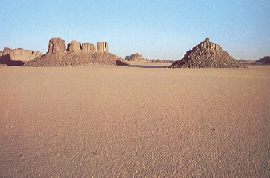
TAHARI TRIBES
Aretai (Arani Luraz Raviri Tashid Ti Zevar)
"To my right were the lines of the Aretai. The Aretai themselves, of course, with black kaffiyeh and white agal cording, held their center. Their right flank was held by the Luraz and the Tashid. Their left flank was held by the Raviri, and four minor tribes, the Ti, the Zevar, the Arani and the Tajuks.
"Tribesman of Gor" page 301
Kavars (Bakahs Char Kashani Ta'kara)
~ Bakahs
"The oasis of Two Scimitars is an out-of-the-way oasis, under the hegemony of the Bakahs, which, for more than two hundred years, following their defeat in the Silk War of 8,110 C.A., has been a vassal tribe of the Kavars."
"Tribesmen of Gor" page 151
~ Char
"This was an oasis of the Char, also a vassal tribe of the Kavars. Its name had been given to it centuries before, when thirsty men, who had moved at night on the desert, had come upon it, discovering it."
"Tribesmen of Gor" page 105
~ Kashani
~ Ta'kara
�Kavars,� he said. �Tribesmen. And men of their vassal tribe, the Ta�Kara.� He looked at me closely. �There may soon be war,� he said. �Caravans will be few. Merchants will not care to risk their goods."
"Tribesman of Gor" page 93
Tajuk
"The Tajuks are not actually a vassal tribe of the Aretai, though they ride with them. More than two hundred years ago a wandering Tajuk had been rescued in the desert by Aretai riders, who had treated him well, and had given him water and a kaiila. The man had found his way back to his own tents. Since that time the Tajuks had, whenever they heard the Aretai were gathering, and summoning tribes, come to ride with them. They had never been summoned by the Aretai, who had no right to do this, but they had never failed to come.
"Tribesman of Gor" page 301
GEOGRAPHY
The Tahari
"It was roughly in the shape of a gigantic, lengthy trapezoid, with eastward leaning sides. At its northwestern corner lay Tor, West of Tor, on the Lower Fayeen, a sluggish, meandering tributary, like the Upper Fayeen, to the Cartius, lay the river Port of Kasra, known for its export of salt."
"Tribesmen of Gor" Page 32
"The area, in extent, east of Tor, was hundreds of pasangs in depth, and perhaps thousands in length. The Gorean expression for this area simply means the Wastes, or the Emptiness. It is a vast area, and generally rocky, and hilly, save in the dune country. It is almost constantly windblown and almost waterless. In areas it has been centuries between rains. Its oases are fed from underground rivers flowing southeastward from the Voltai slopes. The water, seeping underground, eventually, in places, due to rock formation, erupts in oasis springs, or, more usually, is reached by deep wells, some of them more than two hundred feet deep. It takes more than a hundred and fifty years for some of this water to make the underground journey, seeping hundreds of feet at times beneath the dry surface, moving only a few miles a year, to reach the eases. Diurnal air temperatures in the shade are commonly in the range of 120 degrees Fahrenheit. Surface temperature, diurnally, is, of course, much higher in the dune country, by day, if one were so unwise as to go barefoot, the bright sand would quickly cripple a man, abraiding and burning the flesh from his feet in a matter of hours."
"Tribesmen of Gor" Page 33
In the Tahari there is an almost constant wind. It is a hot wind, but the nomads and the men who ply the Tahari welcome it. Without it, the desert would be almost unbearable, even to those with water and whose bodies are shielded from the sun.
I listened to the caravan bells, which sound is pleasing. The kaiila moved slowly.
Prevailingly, the wind in the Tahari blows from the north or northwest. There is little to fear from it, except, in the spring, should it rise and shift to the east, or, in the fall, should it blow westward.
We were moving through hilly country, with much scrub brush. There were many large rocks strewn about. Underfoot there was much dust and gravel.
On the shaded sides of some rocks, and the shaded slopes of hills, here and there, grew stubborn, brownish patches of verr grass. Occasionally we passed a water hole, and the tents of nomads. About some of these water holes there were a dozen or so small trees, flahdah trees, like flat-topped umbrellas on crooked sticks, not more than twenty feet high; they are narrow branched, with lanceolate leaves. About the water, little more than muddy, shallow ponds, save for the flahdahs, nothing grew; only dried, cracked earth, whitish and buckled, for a radius of more than a quarter of a pasang, could be found; what vegetation there might have been had been grazed off, even to the roots; one could place one�s hand in the cracks in the earth; each crack adjoins others to constitute an extensive reticulated pattern; each square in this pattern is shallowly concave. The nomads, when camping at a watering place, commonly pitch their tent near a tree; this affords them shade; also they place and hang goods in the branches of the tree, using it for storage."
"Tribesman of Gor" page 71
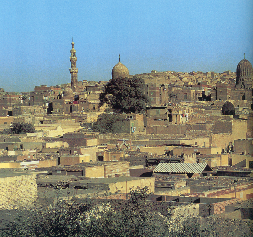
KASRA
"The red salt of Kasra, so called from its port of embarkation, was famed on Gor. It was brought from secret pits and mines, actually, deep in the interior, bound in heavy cylinders on the backs of pack kaiila."
"Tribesman of Gor" page 20
KLIMA
In the distance, below, perhaps five pasangs away, in the hot, concave, white salt bleakness, like a vast, white, shallow bowl, pasangs wide, there were compounds, low, white buildings of mud brick, plastered. There were many of them. They were hard to see in the distance, in the light, but I could make them out.
'Klima,' said Hamid."
"Tribesmen of Gor" page 235
"Most salt at Klima is white, but certain of the mines deliver red salt, red from ferrous oxide in its composition, which is called the Red Salt of Kasra, after its port of embarkation, at the juncture of the Upper and Lower Fayeen."
"Tribesman of Gor" page 238
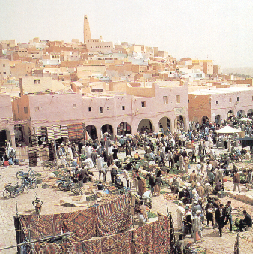
TOR
"Tor, lying at the northwest corner of the Tahari, is the principal supplying point for the scattered oasis communities of that dry vastness, almost a continent of rock, and heat, and wind and sand."
"Tribesmen of Gor" Page 36
"Tor was, as Gorean cities went, rich, trading city. It was headquarters for thousands of caravan merchants. In it, too, were housed many craftsmen, practicing their industries, carvers, varnishers, table makers, gem cutters, jewelers, carders, dyers of cloth, weavers of rugs, tanners, makers of slippers, toolers of leather, potters, glaziers, makers of cups and kettles, weapon smiths, and many others. Much of the city, of course, was organized to support the caravan trade."
"Tribesmen of Gor" Page 39
Architecture
"The buildings of Tor are of mud brick, covered with colored, often flaking, plasters. But now, in the sun, and the dust, raised by the people in the streets, everything seemed drained of color."
"Tribesmen of Gor" Page 38
"The buildings in Tor are seldom more than four stories high, which is about as high as one may build safely with beams and mud brick. Because of the irregular topography of Tor, however, which is a hilly, rocky area, like most of the Tahari terrain, many of the buildings, built on shelves and rises, seemed considerably higher."
"Tribesmen of Gor" Page 38
"These buildings, on the outside smooth and bleak, save for occasional narrow windows, high, not wide enough to admit a body, abut directly on the streets, making the streets like deep, walled alleys. In the center of the street is a gutter. It seldom rains in Tor, but the gutter serves to collect waste, which is often thrown into it, through open doors, by slaves. Within these walls, however, so pressing upon the street, I knew there were often gardens, walled, well-watered, beautiful, and cool, dark rooms, shielded from the heat and sun, many with superb appointments."
"Tribesmen of Gor" Page 38
"Tor, rather similarly, (to the oasis) though few crops were grown within its walls, was built high, about its water, several wells in the deepest area in the city. The architecture of Tor, in concentric circles, broken by numerous, narrow, crooked streets, was a function of the radius from its wells. An advantage of this municipal organization, of course, though it is scarcely a matter of intentional design, is that the water is in the most protected portion of the city, its center."
"Tribesmen of Gor" Page 40
"Tor's water, I might mention, was ample to her needs. Though I saw few of them, she boasted many shaded gardens. Water for these gardens, by contract with slave masters, was carried by chains of male slaves and emptied into house cisterns, whence, later, by house slaves, it would be taken in cans and sprinkled carefully, foot by foot, throughout the garden."
"Tribesmen of Gor" Page 40
"Much of the city, of course, was organized to support the caravan trade. There were many walled, guarded warehouses, requiring their staffs of scribes and guards, and, in hundreds of hovels, lived kaiila tenders, drovers, and such, who would, at the caravan tables, when their moneys had been exhausted, apply, if accepted, making their mark on the roster, once more for a post with some new caravan. Guards for these caravans, incidentally, were usually known by, and retained by, caravan merchants between caravans. They were known men. Tenders and drovers, on the whole, came and went. Elaborate random selection devices, utilizing coins and sticks, and formulas, were sometimes used by merchants to assure that applying tenders and drovers were selected, if they were not known, by chance. Tenders and drovers were assured that this was to insure fairness. Actually, of course, as was well known, this was a precaution against the danger of hiring, en bloc, unwittingly, an organized group of men, who might, prior to their hiring, have formed a plan to slay the guards and merchants and make off with the caravan. Tenders and drovers, however, like men generally, were an honest sort."
"Tribesmen of Gor" page 40
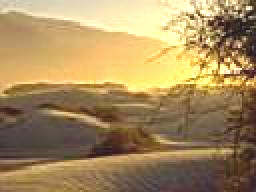
OASES
Oasis Communities
"These communities, sometimes quite large, numbering in hundreds, sometimes thousands of citizens depending on the water available, are often hundreds of pasangs apart. They depend on caravans, usually from Tor, sometimes from Kasra, sometimes even from far Turia, to supply many of their needs. In turn, of course, caravans export the products of the oases."
"Tribesmen of Gor" Page36/7
"The water in an oasis is, of course, at its lowest point. Residences, at an oasis, are built on the higher ground, where nothing will grow. It is the valley, naturally, which, irrigated, usually by hand, though sometimes with clumsy wooden machinery, supports the agriculture. Land, at an oasis, which will grow food, is not wasted on domiciles."
"tribesmen of Gor" Page 40
Oasis of the Battle of Red
"..the Oasis of the Battle of Red Rock was the last of the major oases of the Tahari for more than two thousand pasangs eastward; it lay, in effect, on the borders of the dreaded dune country..."
"Tribesmen of Gor" page 179
The oasis which we were entering is named for the Battle of Red Rock, which is a large shelf of reddish sandstone behind the oasis, north by northeast from its lowest point, and center."
"Tribesmen of Gor" page 179
Oasis of Farad
�She was bought for two tarsks, from a caravan master named Zad of the Oasis of Farad,� he said.
"Tribesmen of Gor" page 179
Oasis of Four Palm
"The march of Hassan had as its object not Red Rock, northwest of Klima, but Four Palms, a Kavar outpost known, to him, which lay far to the south of Red Rock. Unfortunately Four Palms was farther from Klima than Red Rock. On the other hand, his decision seemed to me a sound one. Red Rock was a Tashid oasis under the hegemony of the Aretai, enemies of the Kavars. Furthermore, between Klima and Red Rock lay the regions patrolled by the men of Abdul, the Salt Ubar, who had been known to me as Ibn Saran. Beyond this, though Four Palms lay farther from Klima than Red Rock, its route, it seemed, would bring one sooner out of the dune country than the route to Red Rock, and into the typical Tahari terrain of rock and scrub, where some game might be found, occasional water and possible nomadic groups not disposed to hostility toward Kavars."
"Tribesmen of Gor" page 271
Oasis of Nine Wells
"I was returning to my compartment in Tor, from the tents of Farouk of Kasra. He was a merchant. He was camping in the vicinity of the city while purchasing kaiila for a caravan to the Oasis of Nine Wells. This oasis is held by Suleiman, master of a thousand lances, Suleiman of the Aretai."
"Tribesmen of Gor" page 60
"I had failed to contact them in Kasra, as I had planned, but I had learned that they were in the region of Tor, purchasing kaiila, for a caravan to the kasbah, or fortress, of Suleiman, of the Aretai tribe, master of a thousand lances, Ubar of the Oasis of Nine Wells."
"Tribesmen of Gor" page 44
"'They are Aretai,' said one of the drovers. The caravan, I knew, was bound for the Oasis of Nine Wells. It was held by Suleiman, master of a thousand lances. He was high pasha of the Aretai."
"Tribesmen of Gor" page 82
Oasis of the Sand Sleen
"�Six days ago,� said the merchant, �soldiers, Aretai, from Nine Wells raided the Oasis of the Sand Sleen.� �Six days ago,� said the merchant, �soldiers, Aretai, from Nine Wells raided the Oasis of the Sand Sleen.�"
"Tribesmen of Gor" page 152
Oasis of the Stones of Silver
"It is their intention that Suleiman not receive these goods. It is their intention to divert them, or most of them, to the Oasis of the Stones of Silver.� This was an oasis of the Char, also a vassal tribe of the Kavars. Its name had been given to it centuries before, when thirsty men, who had moved at night on the desert, had come upon it, discovering it. Dew had formed on the large flat stones thereabout and, in the light of the dawn, had made them, from a distance, seem to glint like silver."
"Tribesmen of Gor" page 94
Oasis of Two Scimitars
"The oasis of Two Scimitars is an out-of-the-way oasis, under the hegemony of the Bakahs, which, for more than two hundred years, following their defeat in the Silk War of 8,110 C.A., has been a vassal tribe of the Kavars."
"Tribesmen of Gor" page 151
ECONOMY
Agriculture
"A great amount of farming, or perhaps one should speak of gardening, is done at the oasis, but little of this is exported. At the oasis will be grown a hybrid, brownish Sa-Tarna, adapted to the heat of the desert; most Sa-Tarna is yellow; and beans, berries, onions tuber suls, various sorts of melons, a foliated leaf vegetable, called Katch, and various root vegetables, such as turnips, carrots, radishes, of the sphere and cylinder varieties, and korts, a large, brownish-skinned, thick-skinned, sphere-shaped vegetable, usually some six inches in width, the interior of which is yellowish, fibrous and heavily seeded. At the oasis, because of the warm climate, the farmers can grow two or more crops a year. Larma and tospits are also grown at the oases, in small orchards. Some rep is grown, for cloth, but most cloth comes to the oases from caravans."
"Tribesmen of Gor" Page 37
"In the cafes I had feasted well. I had had verr meat, cut in chunks and threaded on a metal rod, with slices of peppers and larma, and roasted; vulo stew with raisins, nuts, onions and honey; a kort with melted cheese and nutmeg; hot Bazi tea, sugared and later, Turian wine."
"Tribesmen of Gor" page 48
"I brushed away two sellers of apricots and spices."
"Tribesmen of Gor" page 45
"A veiled woman was hawking dates by the tefa."
"Tribesmen of Gor" page 46
"Buy melons!" called a fellow next to her, lifting one of the yellowish, red-striped spheres toward me."
"Tribesmen of Gor" page 45"
"I had nearly stepped into a basket of plums."
"Tribesmen of Gor" page 45
"Pomegranate orchards lie at the east of the oasis," I said. "Gardens lie inward. There is even a pond, between two of the groves of date palms."
"Tribesmen of Gor" page 111?
"I was mildly surprised that the boy had been eating the tospit raw, for they are quite bitter, but, I knew, that the people of the Tahari regions, these bright, hot regions, relished strong tastes and smells."
"Tribesman of Gor" page 46
"Some of the peppers and spices, relished even by children in the Tharai districts, were sufficient to convince an average good fellow of Thentis or Ar that the roof of his mouth and his tongue were being torn out of his head,"
"Tribesman of Gor" page 46
Salt Mining
"In Gor's geologic past it seems that the salt districts, like scattered puddles of crystalline residue, are what remains of what was once an inland salt sea or several such. It may be that, in remote times, an arm of Thassa extended here, or did extend here and then, later, in seismic dislocations or continental drift, became isolated from the parent body of water, leaving behind one or more smaller salt seas. Or it may be that the seas were independent, being fed by rivers, washing down accumulated salt from rocks over millions of square pasangs. It is not known."
"Tribesmen of Gor" page 238
"The salt in solution is obtained in two ways, by drilling and flush mining and, in the deeper pits, by sending men below to fetch the brine."
"Tribesmen of Gor" page 239
"Some of these deposits are far below the surface of the Tahari. Men live in some of them, for weeks at a time. In other areas, certain of these solid deposits are exposed and are worked rather in the manner of open mining or quarries. In places these salt mountains are more than six hundred feet high."
"Tribesmen of Gor" page 239
"Whereas salt may be obtained from sea water and by burning seaweed, as is sometimes done in Torvaldsland, and there are various districts on Gor where salt, solid or in solution, may be obtained, by far the most extensive and richest of known Gor's salt deposits are to be found concentrated in the Tahari. Tahari salt accounts, in its varieties, I would suspect, for some twenty percent of the salt and salt-related products, such as medicines and antiseptics, preservatives, cleansers, bleaches, bottle glass, which contains soda ash, taken from salt, and tanning chemicals, used on known Gor. Salt is a trading commodity par excellence. There are areas on Gor where salt serves as a currency, being weighed and exchanged much as precious metals. The major protection and control of the Tahari salt, of course, lies in its remoteness, the salt districts, of which there are several, being scattered and isolated in the midst of the dune country, in the long caravan journeys required, and the difficulty or impossibility of obtaining it without knowing the trails, the ways of the desert."
"Tribesmen of Gor" page 208
"At Klima, and other such areas, salt is an industry. Thousands serve there, held captive by the desert. Klima has its own water, but it is dependent on caravans for its foods. These food stores are delivered to scouted areas some pasangs from the compounds, whence they are retrieved later by salt slaves. Similarly, the heavy cylinders of salt, mined and molded at Klima, are carried on the backs of salt slaves from storage areas at Klima to storage areas in the desert, whence they are tallied, sold and distributed to caravans. The cylinders are standardized at ten stone, or a Gorean 'Weight,' which is some forty pounds. A normal kaiila carries ten such cylinders, five to a side. A stronger animal carries sixteen, eight to a side. The load is balanced, always. It is difficult for an animal, or man, of course, to carry an unbalanced load."
"Tribesmen of Gor" page 238
Animal Farming
"Kaiila and verr are found at the oases, but not in great numbers. The herds of these animals are found in the desert. They are kept by nomads, who move them from one area of verr grass to another or from one water hole to another, as the holes, for the season, go dry. Smaller water sources are used in the spring, for these are the first to go dry, larger ones later in the year. No grass grows about these water holes because many animals are brought to them and graze it to the earth. They are usually muddy ponds, with some stunted trees about, centered in the midst of an extensive radius of grassless, cracked, dry earth."
"Tribesmen of Gor" Page 37
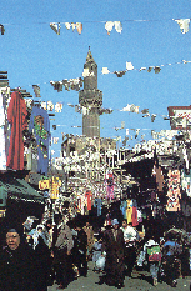
Trade
"To the oases caravans bring various goods, for example, rep-cloth, embroidered cloths, silks, rugs, silver, gold, jewelries, mirrors, kailiauk tusk, perfumes, hides, skins, feathers, precious woods, tools, needles, worked leather goods, salt, nuts and spices, jungle birds, prized as pets, weapons, rough woods, sheets of tin and copper, the tea of Bazi, wool from the bounding Hurt, decorated, beaded whips, female slaves, and many other forms of merchandise. The principal export of the oases is dates and pressed-date bricks. Some of the date palms grow to more than a hundred feet high. It takes ten years before they begin to bear fruit. They will then yield fruit for more than a century."
"Tribesmen of Gor" Page 37
"Meat, hides, and animal-hair cloth are furnished to the oases by the nomads. In turn, from the oases the nomads receive, most importantly, Sa-Tarna grain and the Bazi tea. They receive, as well, of course, other trade goods. Sa-Tarna is the main staple of the nomads. They, in spite of raising herds, eat very little meat. The animals are too precious for their trade value, and their hair and milk, to be often slaughtered for food."
"Tribesmen of Gor" page 37/8
"Guards for these caravans, incidentally, were usually known by, and retained by, caravan merchants between caravans. They were known men. Tenders and drovers, on the whole, came and went. Elaborate random selection devices, utilizing coins and sticks, and formulas, were sometimes used by merchants to assure that applying tenders and drovers were selected, if they were not known, by chance. Tenders and drovers were assured that this was to insure fairness. Actually, of course, as was well known, this was a precaution against the danger of hiring, en bloc, unwittingly, an organized group of men, who might, prior to their hiring, have formed a plan to slay the guards and merchants and make off with the caravan. Tenders and drovers, however, like men generally, were an honest sort."
"Tribesmen of Gor" Page 39
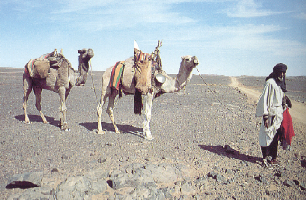
FREE MEN
"A merchant passed me, climbing the stones of the street. He wore a striped, hooded, sleeved, loose robe, a djellaba. The striping was that of the Teehra, a district southwest of Tor, bordering on the Tahari."
"Tribesmen of Gor" Page 44
"Two peasants walked by, in their rough tunics, knee-length, of the white wool of the Hurt."
"Tribesmen of Gor" page 47
Nomads
"Meat, hides, and animal-hair cloth are furnished to the oases by the nomads. In turn, from the oases the nomads receive, most importantly, Sa-Tarna grain and the Bazi tea. They receive, as well, of course, other trade goods. Sa-Tarna is the main staple of the nomads. They, in spite of raising herds, eat very little meat. The animals are too precious for their trade value, and their hair and milk, to be often slaughtered for food."
"Tribesmen of Gor" page 37/8
"A nomad boy of fifteen will often have eaten meat no more than a dozen times in his life. Raiders, however, feast well on meat. The animals mean little to them and come to them cheaply."
"Tribesmen of Gor" Page 38
"Tea is extremely important to the nomads. It is served hot and heavily sugared. It gives them strength then, in virtue of the sugar, and cools them, by making them sweat, as well as stimulating them. It is drunk three small cups at a time, carefully measured."
"Tribesmen of Gor" Page 38
Salt Ubar
"I had heard of the Salt Ubar, or the Guard of the Dunes. The location of his kasbah is secret. Probably, other than his own men, only some few hundred know of it, primarily merchants high in the salt trade, and few of them would know its exact location."
"Tribesmen of Gor" page 207/8
"Nominally a sheriff of the Tahari merchants, he, ensconced in his kasbah, first among fierce warriors, elusive and unscrupulous, possesses a stranglehold on the salt of the Tahari, the vital commerce being ruled and regulated as he wills. He holds within his territories the right of law and execution. In the dunes he is Ubar and the merchants bow their heads to him. The Guard of the Dunes is one of the most dreaded and powerful men in the Tahari."
"Tribesmen of Gor" page 209
"We knew, generally, Red Rock, the kasbah of the Salt Ubar and such, lay northwest of Klima, but, unless one knows the exact direction, the trails, this information is largely useless. Even in a march of a day one could pass, unknowingly, an oasis in the desert, wandering past it, missing it by as little as two or three pasangs.
Knowledge of the trails is vital.
None at Klima knew the trails. The free, their masters, had seen to this.
Moreover, to protect the secrecy of the salt districts, the trails to them were not openly or publicly marked. This was a precaution to maintain the salt monopolies of the Tahari, as though the desert itself would not have been sufficient in this respect."
"Tribesmen of Gor" page 243
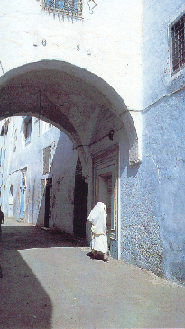
FREE WOMEN
General
"Free women, in the Tahari, incidentally, usually, when out of their houses, also measure their stride. Some fasten their own ankles together with silken thongs. Some dare even the chain, though they retain its key. Free girls, not yet companions, but of an age appropriate for the companionship, sometimes signal their availability to possible swains by belling their left ankles with a single "virgin bell." The note of this bell, which is bright and clear, is easily distinguished from those of the degrading, sensual bells of the slave."
"Tribesmen of Gor" Page 45
"Sometimes free girls, two or more of them, as a girlish lark, obtain slave bells and, chaining their ankles, dress themselves in their haiks and go about the city. Sometimes their girlish amusement does not turn out as they expect. Sometimes they find themselves being sold in markets at obscure eases."
"Tribesmen of Gor" Page 45
Garments
"The haik, black, covers the woman from head to toe. At the eyes, there is a tiny bit of black lace, through which she may see. On her feet were soft, black, nonheeled slippers with curled toes; they were decorated with a line of silver thread."
"Tribesmen of Gor" page 44
SLAVES
General
"There was another reason I had brought Miss Blake-Allen, as we may perhaps speak of her for purposes of simplicity, to the Tahari districts. Cold, white skinned women are of interest to the men of the Tahari. They enjoy putting them in servitude. they enjoy, on their submission mats, turning them into helpless, yielding slaves. Too, blue eyed, blond women are, statistically, rare in the Tahari districts. Those that exist there have been imported as slaves.
"Tribesmen of Gor" page 44
~ Chalwar
"...she wore the sashed chalwar, a sashed, diaphanous trousered garment, full but gathered in, closely, at the ankles..."
"Tribesmen of Gor" page 105
~ Haik
"Following him was a woman, in a black haik. Suddenly I was startled. As she passed me, her stride small and measured, I head the clink of a light chain, the sound of ankle bells. She was a slave beneath the haik, I supposed her collared, naked."
"Tribesmen of Gor" page 45
~ Kurdah
"The girl, startled, cried out. She sat within, her knees to the left, her ankles together, her weight partly on her hands, to the right, on the small, silk-covered cushion of the frame. It was semicircular and about a yard in width at its widest point. The superstructure of the frame rose about four feet above the frame at its highest point, enclosing, as in an open-fronted, flat-bottomed, half globe, its occupant. This frame, however, was covered completely with layers of white rep-cloth, to reflect the sun, with the exception of the front, which was closed with a center-opening curtain, also of white rep-cloth. The wood of the frame is tem-wood. It is light. It is carried by a pack kaiila, strapped to the beast, and steadied on both sides by braces against the pack blankets. This frame is called, in Gorean, the kurdah. It is used to transport women, either slave or free, in the Tahari. The girl was not chained within the kurdah.
"Tribesmen of Gor" page 69
Chains
~ March chain
"Usually the tallest girls lead the slave chain, the height decreasing gradually toward the end of the chain, where the shortest girl is placed. This was a �common chain,� sometimes called a �march chain� or �trekking chain�;
"Tribesmen of Gor" page 14
~ Walking chain
"Following him, in a black haik, was a woman. Suddenly I was startled. As she passed me, her stride small and measured, I heard the clink of light chain, the sound of ankle bells. She was slave. She turned her head, briefly, to look at me; I saw her eyes, dark, through the tiny opening in the haik, through the tiny, black-lace screen, about an inch in height and four inches in width."
"Tribesmen of Gor" Page 44/5
"The use of a light walking chain, tethering the ankles, meant to be worn abroad, accompanying the master, incidentally, is not uncommon in the regions of the Tahari. A beautifully measured gait is thought, in the Tahari, to be attractive in a woman."
"Tribesmen of Gor" page 45
"I paused before a given stall, where light walking chains were being sold. They were strung over racks rather like parrot perches. Without much haggling, I bought one, which seemed to me pretty. They are adjustable, with rings, from a length as small as two inches, for security, to a stride length of about twenty inches. Two keys are provided, each of which fits both ankle-ring locks."
"Tribesmen of Gor" page 49
Serving
"She carried a tray, on which were various spoons and sugars. She knelt, placing her tray upon the table. With a tiny spoon, its tip no more than a tenth of a hort in diameter, she placed four measures of white sugar, and six of yellow, in the cup; with two stirring spoons, one for the white sugar, another for the yellow, she stirred the beverage after each measure."
"Tribesmen of Gor" page 89
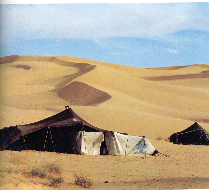
~ CULTURE AND TRADITIONS ~
Greetings
"I extended my hand to Ibn Saran and he, bowing twice, brushed twice the palm of his hand against mine. 'May you always have water, may your water bags never be empty.' "
"Tribesmen of Gor" Page 21
"Tal, Master,' they said to me. 'Tal, Slave Girls,' I said to them."
"Tribesmen of Gor" page 345
"The girls stood straight, proud under the gaze of a warrior. `Tal, Master,' said many of them, as I rode slowly by."
"Tribesmen of Gor" page 344
Brotherhood
"Ride Free," he said.
"I will," I said.
"I can teach you nothing more," he said.
I was silent.
"Let there be salt between us," he said.
"Let there be salt between us," I said.
He placed salt from the small dish on the back of his right wrist. He looked at me. His eyes were narrow.
"I trust," said he, "you have not made jest of me."
"No," I said.
"In your hand," he said, "steel is live, like a bird."
The judge nodded assent. The boy's eyes shone. He stood back.
"I have never seen this, to this extent, in another man." He looked at me. "Who are you?" he asked.
I placed salt on the back of my right wrist. "One who shares salt with you," I said.
"It is enough," he said.
I touched my tongue to the salt in the sweat of his right wrist, and he touched his tongue to the salt on my right wrist.
"We have shared salt," he said.
"Tribesman of Gor" page 60
Tatoos
"The captain looked at me. �Sleeve,� he said. I thrust back the sleeve of my shirt, revealing my left forearm. It did not bear the blue scimitar, tattooed on the forearm of a Kavar boy at puberty."
"Tribesmen of Gor" 83
Games - Zar
"The board is marked like a Kaissa board, but the pieces - 9 per player, and called 'pebbles' - are placed at the intersections of the lines. Movement is somewhat like that of checkers, but without capturing of pieces. The object of the game is to effect a complete exchange of the original placement of the pieces"
Tribesmen of Gor"
Song of the Caravans of Tor
"Her fingers touched the six strings, a note at a time, and then a melody, of the caravans of Tor, a song of love."
"Assassin of Gor" page 264
Gifts
"That night, when our repast had been finished, and a clothed, bangled slave woman, the property of Farouk, had rinsed our right hands with verminium water, poured over our hand, into a small, swallow bowl of beaten copper, I drew forth from my robes a small, flat, closed Gorean chronometer. It was squarish. I placed it in the hands of the boy, Achmed. He opened it. He observed the tiny hands, moving. There are twenty hours, or Ahn, in the Gorean day. The hands of the Gorean chronometers do not move as the hands of the clocks of the Earth. They turn in the opposite direction. In that sense, they move counter clockwise. This chronometer, tooled in Ar, was a fine one, sturdy, exact. It contained, too, a sweeping Ihn hand, with which the tiny Ihn could be measured. The boy watched the hands. Such instruments were rare in the Tahari region. He looked at me.
"It is yours," I told him. "it is a gift," The boy placed the chronometer in the hand of his father, offering it to him. Farouk, merchant of Kasra, smiled. The boy then, carrying the chronometer took it about the circle of the small fire, on the sand of the tent; before each of his kinsmen, he stopped; into the hands of each, he placed the chronometer. "I give you this." he said. Each looked at the chronometer. Then each handed it back to the boy. The boy returned and sat next to me. He looked at his father. "You will tell the time," said Farouk of Kasra, "by the speed of your kaiila, by the circle and the stick, by the sun."
"Tribesman of Gor" page 61
Weapons
"I knew the light lance, and the swift, silken kaiila. I had learned these with the Wagon Peoples. But I did not know the scimitar. The short sword, now slung over my left shoulder, in the common fashion, would be of little use on kaiila back. The men of the Tahari do not fight on foot. A man on foot in the desert, in warfare, is accounted a dead man."
"Tribesmen of Gor" page 39
~ FAUNA ~
Kaiila
"Kaiila and verr are found at the oases, but not in great numbers. The herds of these animals are found in the desert."
"Tribesmen of Gor" Page 37
Lelt
"Lelts are often attracted to the salt rafts, largely by the vibrations in the water, picked up by their abnormally developed lateral-line protrusions, and their fernlike cranial vibration receptors, from the cones and poles. Too, though they are blind, I think either the light, or the heat, perhaps, from our lamps, draws them. The tiny, eyeless heads will thrust from the water, and the fernlike filaments at the side of the head will open and lift, orienting themselves to one or the other of the lamps. The lelt is commonly five to seven inches in length. It is white, and long-finned. It swims slowly and smoothly, its fins moving the water very little, which apparently contributes to its own concealment in a blind environment and makes it easier to detect the vibrations of its prey, any of several varieties of tiny segmented creatures, predominantly isopods. The brain of the lelt is interesting, containing an unusually developed odor-perception center and two vibration-reception centers. Its organ of balance, or hidden "ear," is also unusually large, and is connected with an unusually large balance center in its brain. Its visual center, on the other hand, is stunted and undeveloped, a remnant, a vague genetic memory of an organ long discarded in its evolution."
"Tribesmen of Gor" page 247
Salamanders
"Among the lelts, too, were, here and there, tiny salamanders, they, too, white and blind. Like the lelts, they were, for their size, long-bodied, were capable of long periods of domancy and possessed a slow metabolism, useful in an environment in which food is not plentiful. Unlike the lelts, they had long stem like legs, but the filaments, in the case of the salamanders, interestingly, are not vibration receptors, but feather gills, an external gill system."
"Tribesmen of Gor" pages 247/8
Sand Flies
"Following such rains, great clouds of sand flies appear, wakened from dormancy. These feast on kaiila and men. Normally, flying insects are found only in the vicinity of the oasis."
"Tribesmen of Gor" page 152
Shark
"We saw the broad, blunt head, eyeless, white. On the whitish back, near the high dorsal fin, there was a long scar. Part of the dorsal fin itself was rent, and scarred. These were lance marks. At the top of the food chain in the pits, a descendant, dark-adapted, of the terrors of the ancient seas, stood the long-bodied, nine-gilled salt shark."
"Tribesmen of Gor" page 249
Verr
"Kaiila and verr are found at the oases, but not in great numbers. The herds of these animals are found in the desert."
"Tribesmen of Gor" Page 37
Vint
"I detected the odor of kort rinds, matted, drying, on the stones, where they had been scattered from my supper the evening before. Vints, insects, tiny, sand-colored, covered them."
"Tribesmen of Gor" page 115
Zad
"I heard, a short time later, wings, the alighting of one or more large birds. Such birds, broad-winged, black and white, from afar, follow the marches to Klima; their beaks, yellowish, narrow, are long and slightly hooked at the end, useful for probing and tearing. The birds scattered, squawking, as a Kaiila sped past. The birds are called zads."
"Tribesmen of Gor" page 232
Zadit
"The zadit is a small, tawny-feathered, sharp-billed bird. It feeds on insects. When sand flies and other insects, emergent after rains, infest kaiila, they frequently light on the animals, and remain for some hours, hunting insects. This relieves the kaiila of the insects but leaves it with numerous small wounds, which are unpleasant and irritating, where the bird had dug insects out of its hide."
"Tribesmen of Gor" page 152
~ FLORA ~
Telekint
"The rep-cloth veil was red; it had been soaked in a primitive dye, mixed from water and the mashed roots of the telekint; when he perspired, it had run; his face was stained."
"Tribesmen of Gor" page 83
Veminium
"The petals of veminium, the 'Desert Veminium,' purplish, as opposed to the 'Thentis Veminium,' bluish, which flower grows at the edge of the Tahari,
"Tribesmen of Gor" pages 50/51
"(...) gathered in a shallow basket sand carried to a still, are boiled in water. The vapor which boils off is condensed into oil. This oil is used to perfume water. This water is not drunk but is used in middle and upper-class homes to rinse the eating hand, before and after the evening meal."
"Tribesmen of Gor" pages 50/51
Verr grass
"On the shaded sides of some rocks, and the shaded slopes of hills, here and there, grew stubborn, brownish patches of verr grass.
"Tribesmen of Gor" page 71

